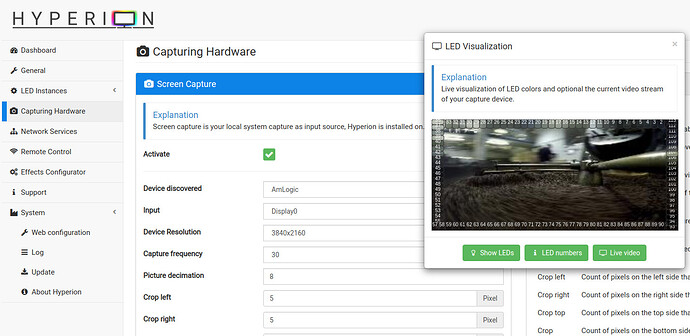Thank you, Portisch. I found one major difference. While my Ubuntu implementation shows an hyperion buffer (aml) of 4k, CoreElec only shows FullHD (1920x1080). With this smaller buffer size I can always grab the complete video picture.
This leads me to the question: How can CoreElec show 4K output, while the grab is only at FHD? I guess this has something to do with buffer settings (fb0, …). Any idea? Thank you again for your help.
@Portisch: I just wanted to let you know that I made it using Ubuntu. I generated a new kernel. For this kernel I replaced all Ubuntu media and media_module files with CoreElec ones (with the exception of the HDMI driver in order to get rid of several warning messages during kernel compilation).
For FHD this is working perfectly, For UHD I only need to patch hyperion.db and replace in the framegrabber UHD resolution by FHD resolution. For ambilight this is no problem at all, because the picture itself will be down-scaled anyway.
The only small problem which remains is that video in VDR with odroid output plugin switches off and needs to by re-enabled by echo 0 > /sys/class/video/disable_video. If you habe any idea why this happens, I will be happy to listen to this idea. However, here is an easy workaround by simply activating the video (again) before feeding the video decoder. Thank you once again for your kind help.
For such handling you need to study Kodi.
Like this:
And this:
I found it. Thank you!
@Portisch : May I please ask you another favor: Could you please let me know what was changed in the CE kernel to get rid of the video slowdowns. I also experience with my kernel video slowdowns after a while and I guess this is related. You talked about an error in the decoder source, if I remember correctly. Maybe you can show me the commit… Thank you once again!
in long: Slow down of Hyperion.ng
in short: the user frame request interfered with video thread interrupt function → slow down sometimes.
I read this thread already completely. Could you point me to the kernel commit which solved the problem? I did not find it.
Thank you once again, @Portisch. Very kind of you. Problem with my hyperion Ubuntu kernel ist that I get this
Warning: vh264_vf_put vf ffffff8009013fc0 invalid index
every 10-15 minutes and picture (VDR) gets stuck for a fraction of a second. I know that this is not CE related. However, if you have an idea, I will be more than happy to hear this.
Thank you once again for your kind help. It is highly appreciated!
I answer my question myself: It seems to be ext_frame_capture_poll()-related in video_keeper.c. This function should be called (an empty struct vframe_s * is fine). This solves at least my problem with jitter in picture every 10-15 minutes. I guess can also be interesting for CE team when switching to a newer version of kernel.
After a recent update, I’m having problems where I suffer from decoding artifacts using the AmLogic grabber on an Odroid N2 while playing HEVC content. Anyone else suffering the same issues?
I also made a thread on the hyperion forums here: Video decoding artifacts CoreELEC + Hyperion using Amlogic grabber - Software Support - Hyperion-Project Forum
Hi guys I’ve been running this on my TV for a while recently upgraded TV and retired the old one to the bedroom. Any chance of some suggestions of the best hardware to order for a 65" TV. I don’t mind several weeks shipping from bangood or whatever. If it helps I’m running an odroid c4.
Thanks
Last Hyperion.NG version do support wireless controlled LED strips by mDNS:
If my setup will break I will also go with such WLEDs.
Right now I use a Arduino with LED stripe WS2812B, 5m 150 LEDs for a 55" TV.
But this will be to short for your TV size I guess.
Thanks for the reply, very interesting I might have some stuff already I could test that out with, specifically the Gledopto Pro.
Just in case anyone was looking at this the Gledopto doesn’t work as it connects to the hue Bridge and that won’t allow third party lights to be put in zones. Still well recommend it for other uses.
Hi again, sorry to be a bother, I came across this site and theirs lots of info, too much really. https://kno.wled.ge/ I’m not stupid and have no problem wiring or software side but as it seems you have looked into would you have a specific suggestion for hardware. I’m in the UK if that makes a difference. I miss my backlighting it’s surprising!
If you already run Home Assistant with ESPHome, or just ESPHome, I would recommend an ESP32 chip with APA102 LEDs. You would need a pretty beefy 5V power supply in order to make it work. If you want a lower voltage drop, you could go for a 12V LED strip, but I think the color reproduction is a bit worse. Some ESP32 boards can even be powered from a 12V source, so you won’t even need a buck converter to power those with the same supply. If I would completely redo my setup, I might go for 12V myself, though I would need to look up which LEDs to get to get the best colors.
Thanks for your thoughts, gives me something to look into, 32 or 60 leds per meter, I’ll figure it out eventually. Oh and just looked at dimensions, 5m is plenty to go round a 65" TV, most barely have bezel so there’s about 406cm by my reckoning.
